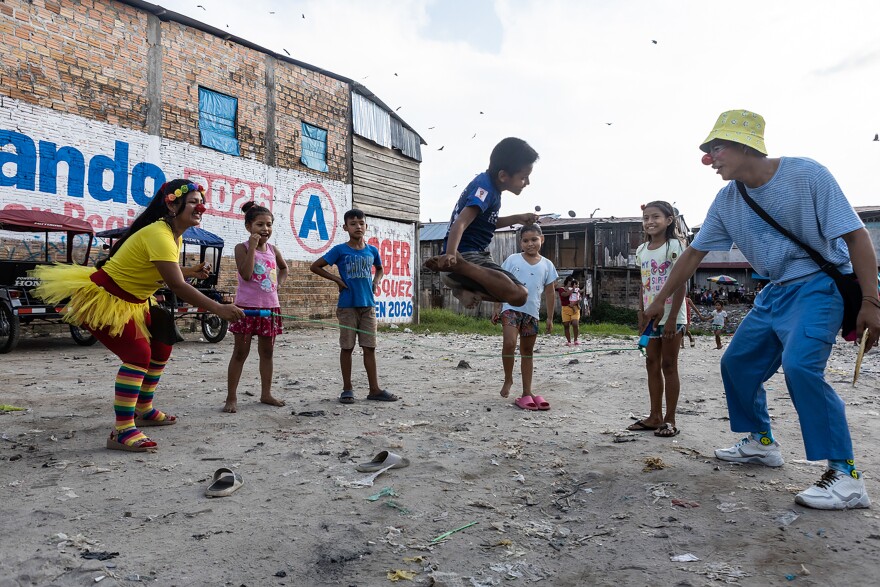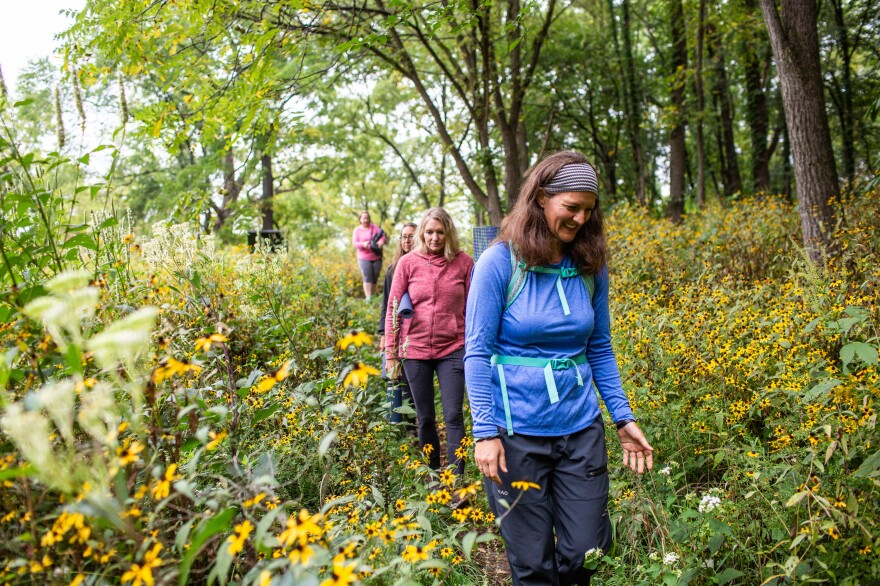March 20 is a day dedicated to joy! Since 2013, the United Nations' International Day of Happiness has recognized the value of happiness as "a fundamental goal" in people's lives around the world.
The happiness campaigns are coordinated by the nonprofit Action for Happiness, which has thousands of members from 193 countries and whose patron is the Dalai Lama. The organization hosts online talks and coaching, and even an app that suggests ways to discover joy.
This year's theme is "Happier Together." The explanation is: "At this time of uncertainty and conflict ... lasting happiness comes from feeling connected to others and being part of something bigger."
We asked the photojournalists of The Everyday Projects — a global community of photographers using images to challenge harmful stereotypes — to look through their archives for scenes that capture a sense of happiness and well-being, from small uplifting moments to big bursts of joy. They shared photos of former child soldiers playing soccer, of finding inspiration by listening to the blues, of teen girls in Ukraine blissfully jumping on a trampoline, of an older couple's moment of togetherness.
Literally jumping for joy

Since Russia's annexation of Crimea in 2014 through today's ongoing war against Ukraine, at least 31,000 Ukrainians have died and about 3.7 million have been internally displaced (IDPs) from their homes.
Among the IDPs are thousands of Jews who were living in the Donbas region of eastern Ukraine, where intense fighting took place. One rabbi, seeing no end to the conflict, built a village for Jewish refugees near Kyiv on the site where a pre-WWII Jewish community had once thrived. In September 2015, about 20 Jewish families from Ukraine abandoned their former lives and relocated to the village of Anatevka.
In this photo from 2016, young Jewish girls from the village school play on a trampoline during a break between classes, finding some solace and fun in the midst of their uprooted lives.
Animal instinct

In 2011, pro-democracy rallies began to challenge the authority of Syrian President Bashar al-Assad as part of the wider Arab Spring movement spreading across North Africa and the Middle East. By 2012, the country was embroiled in a full-blown civil war that has so far claimed the lives of more than 600,000 people and displaced more than 12 million, the largest displacement crisis in the world.
Five-year-old Azzam lost his brother in the conflict, as well as his leg, when a bomb hit the building where he was sheltering with his family. Forced to flee, the struggling family eventually received aid from UNICEF that allowed them to settle in a rural area outside of Damascus and buy some sheep.
The situation in Syria remains volatile. Azzam, now 12, finds happiness and peace caring for the animals each day after school.
Swinging on two palms

Hanan Ali lives with her family in Egypt's Dahshur region, home to some of the country's largest and most well-preserved pyramids. Most of the area's residents earn their livelihoods by growing crops or raising livestock.
The Ali family owns a small piece of land where they grow palm trees. They harvest the dates for export or to sell to local businesses.
In 2017, Hanan enjoys a ride on the swing that her father skillfully crafted between two palm trees as a place for her and her sisters to play.
Happiness is for the birds

Judith Mirembe (in the plaid shirt) leads a bird-watching excursion in November 2023 through the Entebbe Botanical Gardens, located on the shores of Lake Victoria in Uganda. The lush garden is a habitat for several bird species, as well as butterflies, primates and various trees, plants and flowers.
In 2013, Mirembe co-founded the Uganda Women Birders Association as a way to help women break into the male-dominated field of nature guiding, a popular tourist industry in the country, which is home to 50 percent of Africa's bird population. Starting with just 10 members, the club has since grown to more than 60 women who lead birding tours and children's activities, as well as participate in mentorship and research programs. Some have gone on to start their own tour companies or help devise conservation strategies for endangered species.
The success of the Uganda Women Birders Association has inspired similar associations in Rwanda and Kenya, which Mirembe says has made her club very happy. She is excited to see the number of female birdwatchers growing, saying, "We are looking at forming a big network of East African women birders, and who knows, in a few years we can form even a bigger one – the African Women Birders Association – so that we are able to exchange knowledge, share experiences and learn from one another."
Clowning around

In the floating neighborhood of Belen, in the Amazonian city of Iquitos in Peru, about 30,000 residents rely on canoes to get through the tangled maze of structures on stilts. This unique settlement is overcrowded, polluted and extremely poor, without access to sanitation or electricity. Unemployment and alcoholism are all too common. On top of that, Peru had the world's highest death rate from COVID-19, and the pandemic wreaked havoc in Belen.
Before COVID, entertainers would visit Belen from the West Virginia-based Gesundheit Institute, a nonprofit founded by Dr. (and clown) Patch Adams that offers a free and holistic approach to healthcare. Adams organizes volunteers worldwide to perform as clowns for orphanages, refugee camps, natural disaster sites and poverty-stricken areas, in addition to the more serious business of building clinics and aiding other community development projects.
But the pandemic put a stop to all of that for Belen. In 2023, the clowns finally returned – and the immense joy of the inhabitants was palpable as they laughed, connected with neighbors and played outside. As Patch Adams knew, laughter is the best medicine.
From soldiers to soccer players

The predominantly Hutu FDLR (Democratic Forces for the Liberation of Rwanda), founded by some of the leaders of the Rwandan genocide in 1994, became one of the largest guerrilla groups in the Democratic Republic of the Congo. FDLR forcibly recruited or kidnapped thousands of children for its ranks. These youngsters lived for years in the bush and acted as fighters, messengers, spies and sex slaves. As global attempts to disband armed militias got under way, some child soldiers escaped or were taken to a UNICEF transitory care center in the DRC city of Goma on the Congo-Rwanda border.
Here, in 2007, former child soldiers play soccer at the center, relishing a taste of play rather than war.
A cheerful churro maker

In the morning, Martin Elizalde Valenzuela paints houses. But in the afternoons, he says, "I come to relax and be happy selling churros," which he has been doing for 25 years from his street stand just outside the church of Our Lady of Santa Anita in Jalisco, Mexico. This photo was taken the day after Christmas in 2022.
"Everyone tells me that I look older than I am," says Valenzuela, 59. "It's because life has worked me!" he says with a laugh. Until he was 34, he sold fruit in a market. But he noticed that no one was selling churros in Santa Anita, so he decided to set up shop with the help of a friend from nearby Guadalajara who taught him the art.
He feels happy when he sees people delighting in his fried dough sticks topped with cinnamon and sugar. "People from Japan, Canada, Spain have come to enjoy my churros," he says with pride. "There are people who ask me to take them frozen to other countries. It makes me happy to know that my churros are going to other countries."
And while he's happy to share his churros, he's not going to share his recipe. "My recipe for making the churros so good is a secret ... and no one else knows it!" he says playfully.
Happy blues

Dancers move across the floor at Red's Juke Joint in Clarkdale, Miss. in 2016.
Blues music traces its roots to the slave fields of Mississippi, which calls itself the "Birthplace of American Music," and has spawned such greats as B.B. King, Robert Johnson and Elvis Presley. After emancipation, independent juke joints began springing up along rural roads as a place for Black people – who were barred from white establishments – to socialize and relax. These havens were often located in abandoned or rundown buildings, but offered plentiful food, gambling, moonshine, music and dancing.
Once numbering in the hundreds, few juke joints remain today. The clientele has thinned out due to age, other forms of entertainment (such as casinos), or other kinds of music (such as gospel). But Red's remains true to live blues, a source of joy for over 150 years.
The old couple and the sea

"I took this photo during a family holiday trip to Uruguay and Argentina back in January 2016," says photographer Gustavo Minas. It was the first trip he and his wife, Priscilla, took with daughter Violeta, who was 6 months old at the time. The young family was just starting a new chapter in their story.
At Playa de los Pocitos in Montevideo, Uruguay, they took Violeta swimming for the first time, which Minas recalls as a special moment symbolizing their new lives together. And it was here that Minas noticed this couple and took this candid photo.
"When I saw this sweet old couple entering the sea, hand in hand, I felt totally inspired by what I imagined to be their story and ran to photograph this scene, luckily illuminated by the warm summer light," says Minas.
He says the image is one of his wife's favorites. "We have it framed by our bed, like a wishful thinking," he says.
Bathing in a forest's beauty

Randi Smith, right, and Michelle Kullman join a group "forest bathing" walk at Hoyt Park in Madison, Wisc., in September 2021. Forest bathing, known as shinrin-yoku in Japan, emerged there in the 1980s as a way to unplug from the business of modern life and engage all senses in reconnecting with nature. Forest therapy guide Kate Bast (not pictured) leads the walks through the park, which last from one to four hours. Along the way, she encourages meditation and mindfulness to enhance inner peace and overall well-being.
The benefits go beyond the psychological. Dr. Qing Li, a professor at Nippon Medical School in Tokyo and president of the Japanese Society of forest medicine, has conducted several studies on the practice. Last October, he told NPR's Marielle Segarra, host of Life Kit, that inhaling the chemicals trees release in the air reduces stress hormone levels and boosts immunity.
Smith is a busy mother of two teenagers who says time is often hard to find. But she tries to engage in forest-bathing as often as she can, either solo or accompanied by friends and family. "I'm not a super outdoorsy person and this type of guided walk is attainable. It gives me the encouragement I need to get out there and do something for myself," she says, especially when she needs to "pause the constant comings and goings of daily life."
Laurel Dalrymple is a freelance writer and editor who frequently contributes to NPR.
Copyright 2024 NPR. To see more, visit https://www.npr.org.







